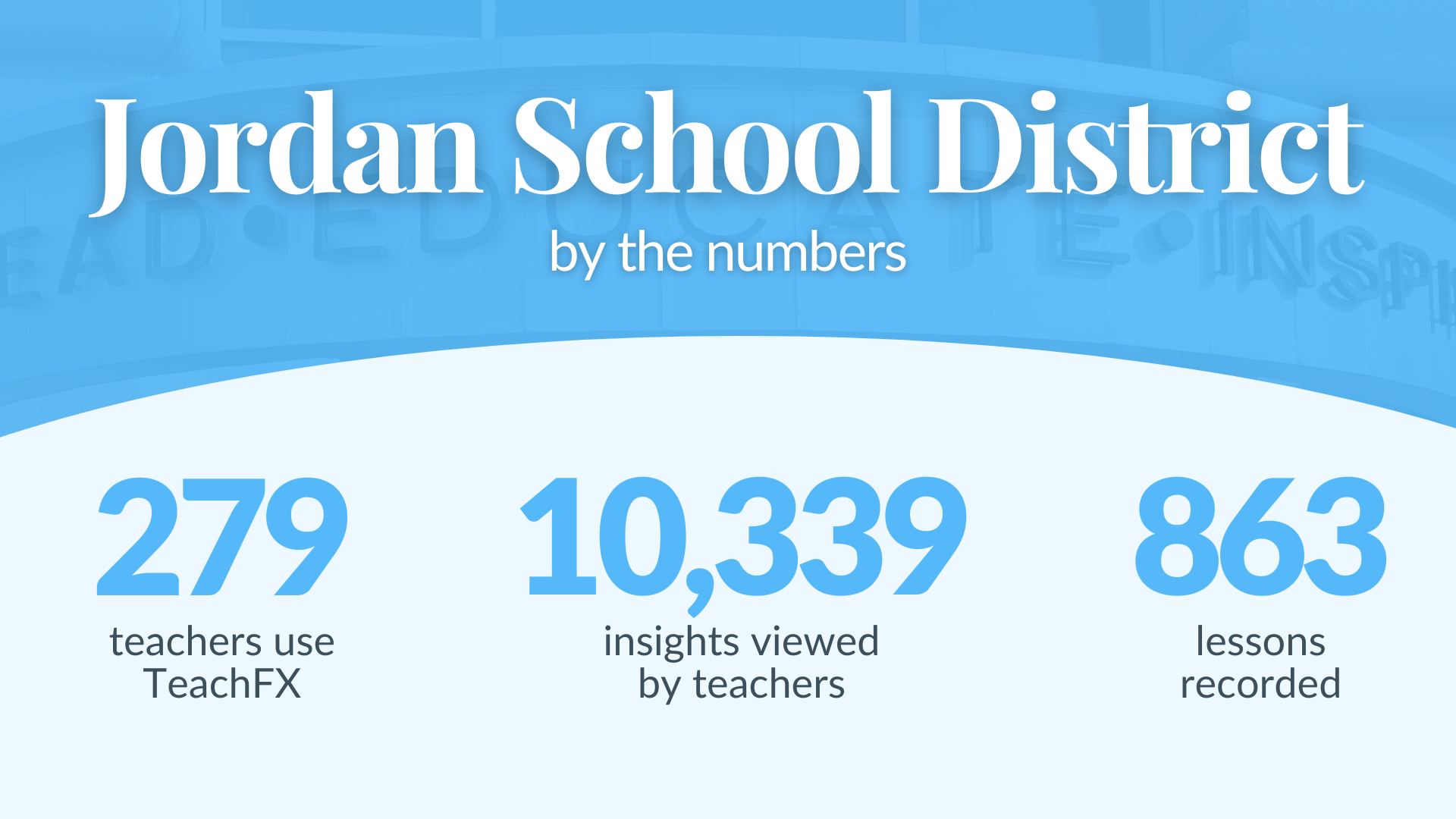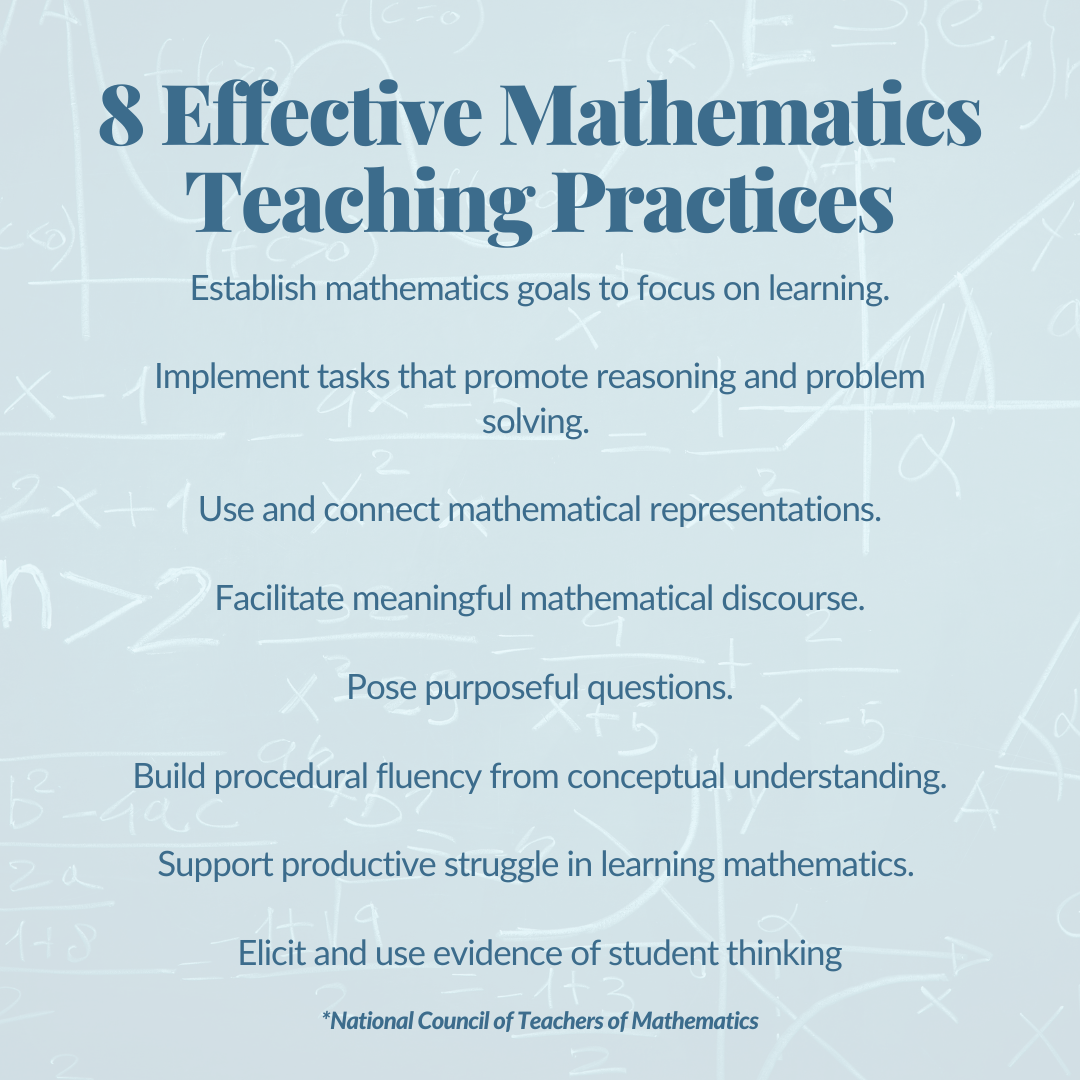Jordan School District: Feedback + Coaching + PD =Joy
Facilitating joyful teaching & engaged learning through:
💡Instructional feedback for self-reflection
🗣️ Instructional coaching through collaboration
🧠 Professional development aligned to teachers’ needs & district priorities
Jordan School District, in Utah’s Salt Lake County, employs nearly 3,500 educators and serves nearly 60,000 students.
The district’s K-12 Mathematics Administrator, Amy Kinder, is on a mission to improve mathematics teaching and learning by bringing joy into the classroom.
But teaching and learning doesn’t change simply because we state an intention. Teaching and learning changes when teachers receive objective feedback, collaborative coaching, and personalized professional development.
With TeachFX, Amy’s department of three educators was able to foster changes in teaching and learning through a three-faceted approach across the 62 schools they support district-wide.
Boosting student engagement in math… starting with joy.
Jordan adopted the eight Standards for Mathematical Practice to focus on the core elements of engaged learning.
These standards are about creating math classrooms that are alive with conversation — and that starts with joy. Joyful teaching and learning helps students persevere in solving problems, construct viable arguments, and engage in learning out loud.
And joyful teaching and learning starts with a joyful approach to professional development that combines three key ingredients: feedback, coaching, and professional development — personalized to each teacher’s needs… but very few teachers get that.
Amy faced the challenges that so many schools and districts face today.
Feedback: Most teachers rarely receive the feedback they need – feedback that’s objective and personalized to their practice, their classroom, and their students (Brazer et al., 2018).
Coaching: While some teachers have an instructional coach, the vast majority don’t. And those who do are often observed just a few times a year (ibid.).
PD: Most professional development is a one-size-fits-all, sit-and-get affair. It’s disconnected from each teacher’s reality in their own classroom and is intensely time-consuming.
In partnership with TeachFX, Amy designed a professional development program that addressed each of these challenges.
Teachers gathered their own, objective feedback, as often as they liked, using the TeachFX instructional coaching app. Coaching became a collaborative process with teachers bringing their own observational data into the experience. And our personalized PD aligned to district priorities, and integrated each teacher’s reflections.
With TeachFX, Amy and her team helped teachers change their practice in the direction they selected, and increased student engagement in Jordan’s elementary and secondary math classrooms.
Instructional feedback for self-reflection
Teachers in Jordan School District were already in the practice of recording themselves.
Using either audio or video, they’d endeavor to reflect on what they saw and heard in their teaching practices and their students’ engagement. But simply having recordings wasn’t enough.
“But we found that we really needed something to give feedback in a meaningful way...And that's where TeachFX was our magic bullet. Teachers were watching this video of themselves, but they still need this feedback that can make that reflection part more powerful.”— Amy Kinder
Whether recording directly with TeachFX, or uploading video files, teachers using TeachFX could now gather in-depth, objective insights into what happened during a lesson.
To start, Amy used TeachFX herself in PD sessions she led with her teachers and reflected on her own insights with her educators.
“Sharing this and talking about it with teachers is so powerful.”
From teacher talk and student talk to the use of academic language to the questions that got students talking and building on each other’s responses, Amy was able to see and share it all.
She was vulnerable about seeing her own areas for growth – like decreasing her own teacher talk time or creating more opportunities for building on student contributions.
She also modeled for teachers how to use data on conversational patterns to identify the most engaging moments and use that to create more meaningful mathematic conversations.
Instructional coaching through collaboration
With TeachFX insights, instructional feedback no longer fell completely on instructional coaches to deliver.
Each instructional coaching session became a collaborative experience in a new way.
Teachers saw for themselves what was happening in their own classrooms, what they wanted to change, and how they wanted to work with their coach towards that change.
Some teachers would work with coaches on things that they were already pretty great at. Seeing the data in their insights gave them inspiration to reach for new goals.
Amy knew this approach was bringing joy into this work when teachers began stopping coaches in the hall, so excited to celebrate the progress they were seeing in their TeachFX insights.
Professional development aligned to teachers’ needs and district priorities
When teachers have a joyful learning experience in their PD, they create a joyful learning experience in their classrooms.
But Amy found that with other PD approaches,“We tell [our teachers], you should teach like this, but they don't ever get to experience it.”
“We can’t simply say to our teachers, ‘I want your students to talk more and do more talking.’”
TeachFX designed PD for Jordan’s teachers that would provide a joyful experience that teachers would carry back to their classrooms, while meeting three key objectives:
Help build NCTM’s effective mathematics teaching practices
Help embrace NCTM’s five equity-based math teaching practices
Support Jordan’s own eight standards for mathematical practice
And the PD was differentiated for the specific needs of elementary and secondary teachers.
For instance, in secondary, teacher talk tends to be direct instruction. So we designed PD that moved from a task-based approach to a more student-centered approach. We talked about student talk, wait time, and sentence stems – powerful tools to get teachers into this student-centered mode.
Each session provided specific practices, and created space to make the learning more reflective for the teacher by weaving their TeachFX data into the practices being taught.
In one PD session, we asked teachers to open up a recent TeachFX report, to look at moments of student talk, and notice when long stretches of student talk happened.
As they reflected more deeply on what they could see in their own classroom insights, they began identifying the moments of student comprehension represented in their student talk.
Suddenly, it wasn't just about the numbers or the ratios, or how many times this or that happened - they were learning what led students to understanding content and celebrating breakthrough moments.
It was inspiring to hear teachers engage in sense-making out loud, and build on each other’s learning, while engaging in PD learning experiences that mirror what they’d like to create in their own classrooms.
Data-informed district-level planning
While teachers’ specific insights are private just to them, TeachFX provides insights into district-wide trends. This helps district and school leaders stayed aligned, connects instructional coaching to district priorities, and allows data-informed decisions about PD areas of focus.
And the results in Jordan speak for themselves.
With 279 teachers gaining insights into 836 lessons, Jordan saw real changes in just seven months:
Student talk increased from 6% to 18%
Teachers increased their wait time, with the highest use of wait time corresponding to the lowest teacher talk and highest student talk.
Teacher talk decreased from 64% to 57%
Because the data is visible, districts and teams can celebrate incremental progress. In Jordan, one cohort of high school teachers started out at 99% teacher talk time. Once they dropped their teacher talk to 90%, they celebrated and were motivated to continue to decrease their talk ratio.They could see the results of the work happening in the classroom, in their coaching, and in their PD.
“Teachers don’t change their practice because the district sets a decree. They make change by saying I'm going to work on my questioning…I chose it…I see a need for that, I can see the growth.” — Amy Kinder
Empowering teachers to create incremental change
There’s a quote that’s stuck with Amy and guided her work for some time – “that it's unprofessional to ask teachers to change more than five to 10% of their practice every year.” But, as Amy sees it, it's also unprofessional for teachers to not refine their practice five to 10%.
The work Jordan School District has done withTeachFX is about incremental improvement. It’s not about leaving teachers feeling like they need to change everything or aren’t doing amazing work - it’s about empowering each teacher to explore how their own practices can create incremental change in their classrooms.
TeachFX is on a mission to help every teacher create classrooms that come alive with more meaningful, equitable dialogue. From elementary to secondary, math to language and everything in between, we are combining the feedback in our instructional coaching app with personalized professional development that honors teachers’ expertise and engages them in new ways.







